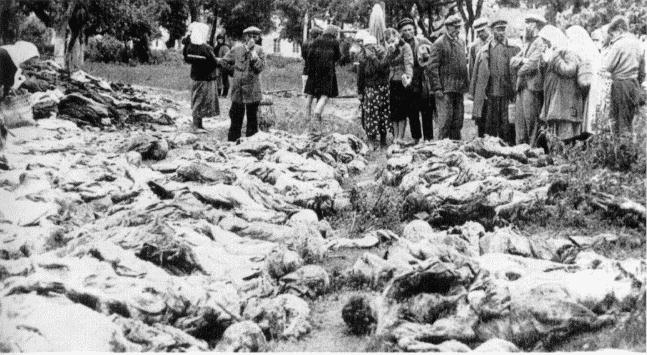
Stéphane Courtois, et al., The Black Book of Communism: Crimes, Terror, Repression, Harvard University Press, Cambridge Massachusetts and London England, 1999, between pp. 202 and 203.
|
October 28, 1999
|
Morley Safer
60 Minutes, CBS Television
51 W 52nd Street
New York, NY
USA 10019
Morley Safer:
Jews massacred Ukrainians in pre-German Lviv
One cannot read the history of the 1941 German invasion of Ukraine without endlessly bumping into accounts of the massacre of Ukrainians by the retreating Jewish-dominated NKVD. In reinforcement of the many quotations which I brought to your attention in my letter to you of 04Jul99, I presently enclose the chapter-long statement of Alfred M. de Zayas, and I add below the briefer statement of Nicolas Werth:
| The rapid German advance in the first months of the war forced the NKVD to evacuate several prisons, labor colonies, and camps that would otherwise have fallen into enemy hands. Between July and December 1941, 210 colonies, 135 prisons, and 27 camps, containing nearly 750,000 prisoners, were transferred to the east. Summarizing "gulag activity in the Great Patriotic War," the Gulag chief, Ivan Nasedkin, claimed that "on the whole, the evacuation of the camps was quite well organized." He went on to add, however, that "because of the shortage of transport, most of the prisoners were evacuated on foot, over distances that sometimes exceeded 600 miles." One can well imagine the condition in which the prisoners arrived at their destinations. When there was not enough time for a camp to be evacuated, as was often the case in the opening weeks of the war, the prisoners were simply executed. This was particularly the case in western Ukraine, where at the end of June 1941 the NKVD massacred 10,000 prisoners in Lviv, 1,200 in the prison at Lutsk, 1,500 in Stanislwow, and 500 in Dubno. When the Germans arrived, they discovered dozens of mass graves in the regions of Lviv, Zhytomyr, and Vynnytsa. Using these "Judeo-Bolshevik atrocities" as a pretext, the Nazi Sonderkommandos in their turn immediately massacred tens of thousands of Jews.
Nicolas Werth in Stéphane Courtois, et al., The Black Book of Communism: Crimes, Terror, Repression, Harvard University Press, Cambridge Massachusetts and London England, 1999, pp. 225-226. |
 |
|
Vynnytsa, Ukraine, June 1943. Here trenches dating from 1937-38 were opened and hundreds of bodies exhumed. The authorities had built a park and summer theater on the site. Similar trenches were discovered in Zhytomyr, Kamenets-Podolski, and other areas. Such macabre discoveries continue even today. In 1997, 1,100 bodies were exhumed in St. Petersburg, and another 9,000 were found in a mass grave in the forests of Karelia.
Stéphane Courtois, et al., The Black Book of Communism: Crimes, Terror, Repression, Harvard University Press, Cambridge Massachusetts and London England, 1999, between pp. 202 and 203. |